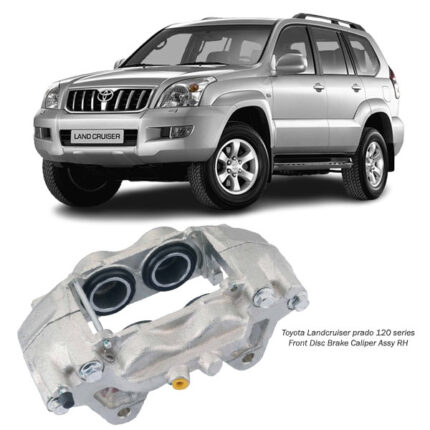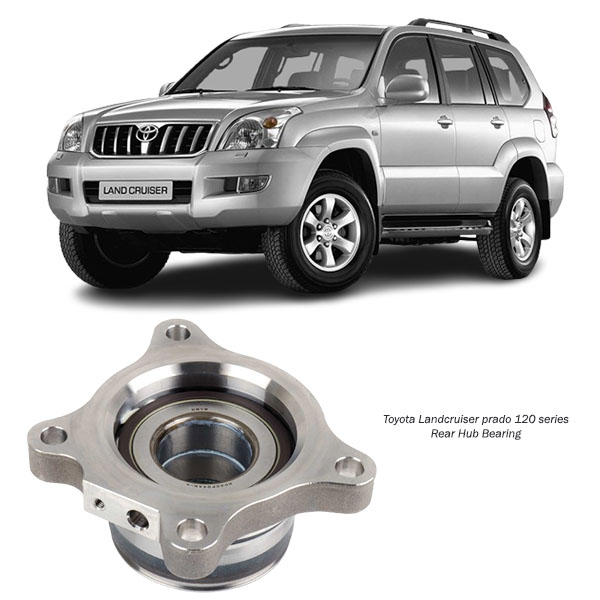-6%
Get Toyota Landcruiser Prad0 120 Series Rear Hub Bearing 42460-60010 in Kenya
When you’re cruising down the road and everything feels smooth and stable, there’s an unsung hero working quietly behind the scenes—your Rear Hub Bearing. It might not be the flashiest part on your vehicle, but it’s absolutely vital for maintaining a smooth, safe, and quiet ride. Let’s explore what this small yet mighty component does, how it works, and why it matters so much. 🚗✨
What is a Rear Hub Bearing? 🤔🔧
To understand this part, let’s first break down the name:
-
Rear – Indicates its position: installed on the rear wheels of your vehicle.
-
Hub – This is the center part of the wheel that connects the wheel to the axle. It’s where the wheel bolts on.
-
Bearing – A precision-made set of steel balls or rollers held together in a ring (called a race) that reduces friction and allows smooth wheel rotation.
So, the Rear Hub Bearing is the part that enables your rear wheels to rotate freely while supporting the weight of the vehicle and withstanding road stress. It’s the quiet, durable component that keeps you rolling. 🛞💨
The Function: More Than Just Spinning 🌀💪
The rear hub bearing plays several important roles:
-
Smooth Wheel Rotation
It allows the wheel to spin with minimal friction, which improves fuel efficiency and ride comfort. -
Load Bearing
It supports the full weight of the vehicle on each rear wheel, including passengers and cargo. -
Absorbing Impact
It cushions road vibrations and absorbs shocks from bumps, potholes, and rough terrain. -
Maintaining Alignment
It helps keep the wheel firmly mounted and in correct alignment for safe handling and tire longevity. -
Support for ABS Sensors
In many modern vehicles, the rear hub bearing assembly also houses sensors for anti-lock braking systems (ABS), feeding crucial data to maintain braking control.
It’s a multi-functional part doing heavy-duty work—all while staying nearly invisible. 🧠🔩
How It Works: Precision in Motion 🎯⚙️
Inside a hub bearing are small steel balls or tapered rollers, usually packed with high-temperature grease and sealed to protect from moisture and debris. These balls or rollers roll along smooth surfaces (called races), allowing the hub—and by extension, the wheel—to spin effortlessly.
The bearing sits snugly between the rotating hub and the stationary axle spindle. As the vehicle moves, the rear hub bearing ensures that the hub can rotate smoothly while keeping everything tightly in place.
Modern rear hub bearings are often sealed units—meaning they can’t be taken apart, repacked, or serviced. They’re designed to be maintenance-free but do eventually wear out after years of service. ⏳🔩
Types of Rear Hub Bearings 🛠️🔍
There are a few different designs of rear hub bearings, depending on vehicle type and performance needs:
-
Ball Bearings – Common in lighter vehicles. They handle both radial (vertical) and axial (side-to-side) loads.
-
Tapered Roller Bearings – Handle higher loads and are used in heavier vehicles or those that require more durability.
-
Double Row Bearings – Contain two rows of balls or rollers, offering extra support and strength.
-
Hub Bearing Assemblies – These are fully integrated units with the bearing pre-installed into a hub with mounting hardware and sometimes ABS sensors.
Regardless of type, the purpose is the same: to support the wheel, reduce friction, and keep everything rolling smooth and safe. 🛞💼
Signs of a Worn Rear Hub Bearing ⚠️🔎
Like all mechanical parts, hub bearings wear out over time. Here are the most common symptoms:
-
Grinding or humming noises from the rear wheels 🧏♂️ – A classic sign the bearing is worn or damaged.
-
Wheel wobble or play – The wheel feels loose or unstable, especially when jacked up and moved by hand.
-
ABS warning light – On vehicles with ABS sensors integrated into the bearing, failure can trigger a warning light.
-
Vibration while driving – As the bearing degrades, it may cause shaking or vibration at certain speeds.
-
Uneven tire wear – A faulty bearing may cause slight misalignment, affecting how the tires contact the road.
If you notice these symptoms, it’s time to have the bearings inspected. Ignoring the issue can lead to unsafe driving conditions or even wheel detachment in extreme cases. 🚨🛑
Causes of Rear Hub Bearing Failure 💥🚧
Several factors contribute to bearing wear:
-
Mileage and Age – Bearings naturally degrade with time and usage.
-
Water or dirt intrusion – Moisture can corrode the internal components.
-
Poor road conditions – Rough terrain and potholes increase the load on bearings.
-
Overloading – Carrying heavy loads regularly accelerates wear.
-
Accidents or hard impacts – A strong hit to the wheel can damage the bearing.
Proper care and routine inspections help prolong the life of your bearings. 🧼🧠
Replacement Process: Precision Required 🔧🧰
Replacing a rear hub bearing involves specialized tools and careful attention. Here’s a typical process:
-
Lifting the vehicle and removing the rear wheel.
-
Detaching brake components like calipers, rotors, and sometimes parking brake assemblies.
-
Unbolting the hub bearing assembly from the suspension knuckle or axle.
-
Installing the new unit using exact torque specs.
-
Reassembling and testing for noise, alignment, and ABS functionality.
Because of its precision role, improper installation can lead to quick failure—so it’s always best handled by trained professionals or with expert guidance. 🧰👨🔧
Maintenance and Longevity 🧼⏱️
Most rear hub bearings are sealed and maintenance-free, but regular inspection can help catch issues early.
Tips to extend lifespan:
-
🚿 Wash undercarriage during rainy or muddy seasons to avoid contamination.
-
🛞 Keep tires properly inflated and balanced.
-
🏋️ Avoid carrying excessive loads regularly.
-
🔍 Get suspension and wheel alignment checked annually.
-
⚙️ Listen for unusual sounds—early diagnosis can prevent complete failure.
A good rear hub bearing can last anywhere from 80,000 km to 150,000 km, depending on driving habits and conditions. 🚗💯
Why It Matters 🧠💥
The rear hub bearing might seem like just another mechanical part, but it affects nearly every aspect of driving:
-
✅ Smoothness – Ensures a comfortable ride.
-
✅ Stability – Keeps your wheel rotating on a fixed axis.
-
✅ Efficiency – Reduces rolling resistance and helps with fuel economy.
-
✅ Safety – Plays a key role in stopping, turning, and handling.
When everything is working as it should, you won’t even notice it. But when it fails—it’s noticeable, noisy, and risky.
In Conclusion: Small Part, Big Responsibility 🛡️🛞
The Rear Hub Bearing may not be flashy, but it’s one of the most critical components supporting your everyday drive. It’s built to take on thousands of kilometers of stress, vibration, and load—all while staying quiet and consistent.
Understanding how it works and recognizing the early signs of wear can help keep your vehicle running smoothly, safely, and efficiently.
So, next time you enjoy a calm, smooth cruise down the road, remember: your rear hub bearings are doing the heavy lifting behind the scenes—turn after turn, kilometer after kilometer.
Follow us on Facebook for more parts.




Reviews
Clear filtersThere are no reviews yet.